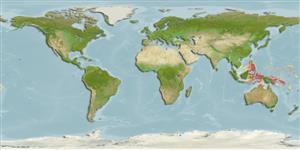Classification / Names
Common names | Synonyms | Catalog of Fishes (gen., sp.) | ITIS | CoL | WoRMS | Cloffa
Actinopterygii (ray-finned fishes) >
Ophidiiformes (Cusk eels) >
Bythitidae (Viviparous brotulas) > Brosmophycinae
Etymology: Alionematichthys: Name from Latin alius meaning the other or different, and nematichthys, the stem of the genus name Dinematichthys, to which this genus is most similar.; plicatosurculus: Named for the characteristic folded inner pseudoclasper (Latin plicatus for folded and surculus for grapevine tendril used for the term pseudoclasper; noun in apposition.. More on author: Schwarzhans.
Environment / Climate / Range
Ecology
Marine; reef-associated; depth range 0 - 10 m (Ref. 81230). Tropical, preferred ?
Western Pacific: Philippines, Indonesia, Papua New Guinea and the Solomon Is.
Size / Weight / Age
Maturity: Lm ? range ? - ? cm
Max length : 7.9 cm SL male/unsexed; (Ref. 81230); 5.8 cm SL (female)
Short description
Morphology | Morphometrics
Dorsal
soft rays
(total): 76-84;
Anal
soft rays: 60 - 67;
Vertebrae: 42 - 45. This species is distinguished by the following characters: D 76-84; A 60-67; moderately large eyes (2.2-3.0%SL); slender body; rounded snout, no cirri; scales only cheeks; upper preopercular pore absent; outer pseudoclasper broad-based, large, sometimes beyond the hood when in resting position, with thickened tip especially on the inner face, while the inner one is large, thick, with posterior lobe folded over anterior pointed lobe; otolith length to height 2.1-2.3, with gently curved dorsal rim; otolith length to sulcus length 1.6-1.7, ostium length to caudal length 3.5-4.5; vertebrae 11-12 + 31-33 = 42-45 (Ref. 81230).
Found on volcanic rock boulders and sandy channels, shallow coral reef (Ref. 81230). Cryptic, solitary inhabitant of shallow water (Ref. 90102).
Life cycle and mating behavior
Maturity | Reproduction | Spawning | Eggs | Fecundity | Larvae
Møller, P.R. and W. Schwarzhans, 2008. Review of the Dinematichthyini (Teleostei, Bythitidae) of the Indo-west Pacific, Part IV. Dinematichthys and two new genera with descriptions of nine new species. The Beagle 24:87-146. (Ref. 81230)
IUCN Red List Status (Ref. 115185)
CITES (Ref. 94142)
Not Evaluated
Threat to humans
Harmless
Human uses
More information
Common namesSynonymsMetabolismPredatorsEcotoxicologyReproductionMaturitySpawningFecundityEggsEgg development
Age/SizeGrowthLength-weightLength-lengthLength-frequenciesMorphometricsMorphologyLarvaeLarval dynamicsRecruitmentAbundance
ReferencesAquacultureAquaculture profileStrainsGeneticsAllele frequenciesHeritabilityDiseasesProcessingMass conversion
Tools
Special reports
Download XML
Internet sources
